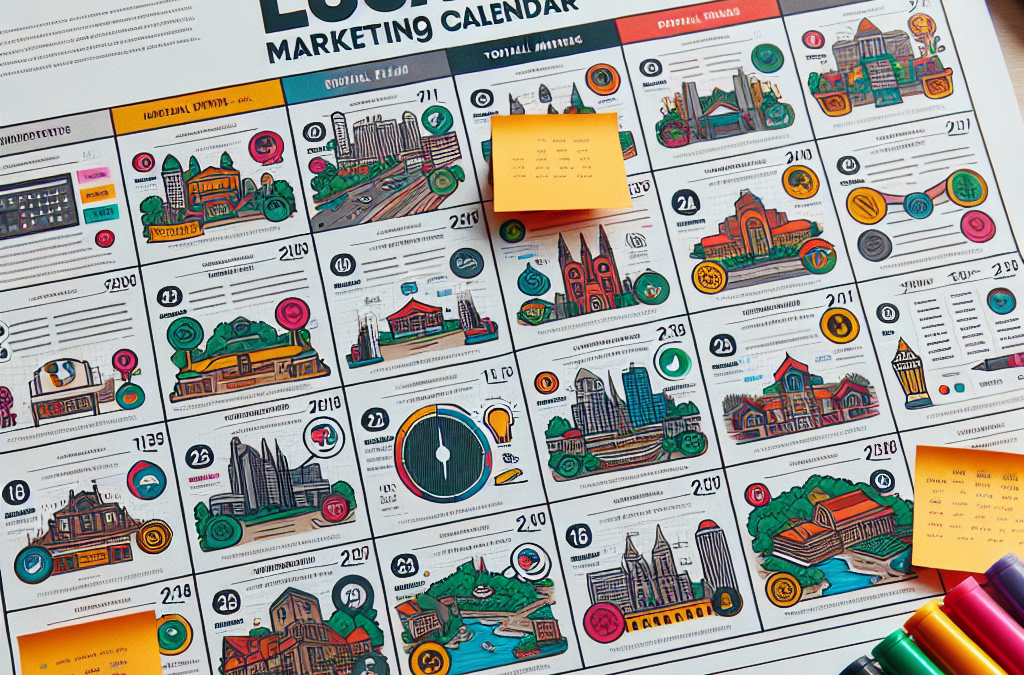Hey folks! Today, I want to share my insights on how to create a killer local marketing calendar. It’s something I’ve honed over the years, and let me tell you, having a structured approach makes a world of difference. So, let’s dive right into the fun part—planning your local marketing efforts!
Set Clear Objectives
Understand Your Goals
The first step in creating a local marketing calendar is to set clear objectives. What do you want to achieve? Maybe you’re aiming to boost sales, increase brand awareness, or connect more deeply with your community. Whatever it is, defining your goals gives your calendar direction.
From my experience, having specific and measurable goals is key. For instance, instead of saying, “I want more customers,” you could say, “I want to increase foot traffic by 20% over the next quarter.” This kind of clarity helps you stay focused.
Remember, it’s all about what success looks like for you. Make sure everyone on your team understands these goals, so you’ll all be on the same page moving forward. Teamwork makes the dream work, right?
Align with Community Events
Next up, align your objectives with local events. Your community is bursting with opportunities like fairs, festivals, or seasonal activities. These are perfect for tying your marketing efforts to what’s happening around you.
For example, if there’s a local food festival, why not plan a special promotion or participate as a vendor? This not only draws in local folks but also enhances your visibility. It’s all about making connections!
Be proactive here! Get involved in planning or promoting these events whenever you can. It builds relationships and positions your brand as a key player in the community.
Track Your Progress
Don’t just set your objectives and forget them—track your progress! I can’t stress enough how important this is. Use tools or analytics to monitor how you’re doing against your goals throughout the year.
This helps you to adjust your strategies on the fly. If something isn’t working, you can pivot and try a different approach. On the flip side, if you see something succeeding, double down on that effort. Trust me, it’s all about optimizing!
Ultimately, tracking your progress helps you refine your strategies and ensures your marketing is always moving forward. Plus, it feels good to celebrate those wins along the way!
Create a Detailed Content Plan
Identify Key Dates
Once you have your goals on lock, the next step is to flesh out a detailed content plan around key dates. Think about holidays, local events, or even your own business milestones. Each of these is a chance to engage with your audience!
For instance, if your bakery has an anniversary coming up, plan a special event or promotion to celebrate! Make sure you note these dates on your calendar, so nothing slips through the cracks.
Also, don’t forget about the local culture—these events can be fantastic triggers for thematic marketing ideas. Embracing the uniqueness of your community is a surefire way to connect better with your audience.
Discuss Content Themes
With the key dates identified, it’s time to brainstorm content themes. What topics will resonate with your audience? It could be promotion around the holidays, educational posts, or community spotlights! Think outside the box here.
From my experience, I’ve found that mixing promotional content with valuable content keeps your audience engaged. Nobody likes a constant sales pitch. Share stories, tips, or even behind-the-scenes content of your business to build relationships.
Creating a diverse content mix not only keeps things interesting but also showcases your brand’s personality. People are more likely to engage with content they feel connected to!
Schedule Regular Posts
Finally, schedule your content regularly. A well-structured calendar helps ensure that you’re consistently engaging with your audience rather than leaving gaps in your communication.
Tools like content calendars can help you visualize everything in one place. This can be a game changer! I swear by them—it helps me stay organized and makes it easier to plan ahead.
Also, don’t be afraid to spread your wings! Experiment with different platforms, timing, and content formats. This keeps your audience engaged and curious about what you are going to bring next.
Engage with Local Customers
Build Relationships Online
Engagement is crucial! In today’s digital age, building relationships online with local customers can’t be overstated. Use social media to create conversations, respond to comments, and share user-generated content.
From my perspective, the more you engage, the more your community warms up to you. People love to feel heard and noticed. So, make an effort to humanize your brand through conversation and interaction!
Hosting live Q&A sessions or even giveaways can be a great way to foster engagement. These opportunities allow customers to feel personally involved with your brand and can enhance loyalty over time.
Participate in Local Initiatives
Don’t just be a bystander; get involved! Participation in local initiatives or charities can enhance your brand’s reputation and help build strong connections within your community.
I had the pleasure of teaming up with a local charity once, and let me tell you, the benefits extended far beyond just good publicity. It showcased our commitment and made many customers feel good about supporting us.
These initiatives are also an opportunity for collaboration with other businesses, which can open doors to new audiences. It creates a vibrant ecosystem where everyone supports each other. Win-win!
Ask for Feedback
Lastly, don’t shy away from asking for feedback! Engage your customers by requesting their thoughts on what you provide, how you could improve, or what they’d like to see in your local offerings.
Surveys, social media polls, or even just a simple ask during transactions can yield priceless insights. In my experience, customer feedback has helped me refine my strategies and offerings significantly.
This also shows your customers that you value their opinions, which builds loyalty and trust. After all, they are the lifeblood of your business!
Measure and Adjust Your Strategies
Utilize Analytics Tools
As you put your marketing calendar into action, it’s important to measure your strategies regularly. Utilize analytics tools to gather data on your campaigns—what’s working and what’s not?
In my early days, I learned the hard way that assuming everything is going well without checking the numbers can cost you. Now, I always keep a close eye on metrics that matter, whether it’s engagement rates or conversion rates.
Analytics will help you understand the effectiveness of your campaigns and enable you to make necessary adjustments. Data-driven decisions are always the way to go!
Stay Flexible
The beauty of having a marketing calendar is that while it gives structure, you should also stay flexible. The market is always changing, and what worked last month might not work in the coming weeks.
Being adaptable allows you to seize new opportunities as they arise or pivot away from underperforming strategies. I’ve found that being responsive to changes often opens up new avenues for success!
So, keep an open mind! Don’t be afraid to change the course if you see something that feels more promising.
Celebrate Your Wins
Finally, don’t forget to celebrate your wins—big or small! Acknowledging accomplishments helps boost morale and motivates you and your team to keep pushing forward.
In my experience, gathering the team to celebrate a successful event or campaign creates a positive work environment and encourages more team collaborations. Everyone loves a little recognition, right?
So, keep a running tally of your successes as you measure your efforts. It’ll inspire you to work even harder, and trust me, you want that good energy flowing!
FAQs
1. How often should I update my local marketing calendar?
It’s best to review and update your local marketing calendar at least monthly. This allows you to stay in tune with any upcoming events or changes in strategy.
2. What kind of tools can I use to manage my marketing calendar?
There are plenty of tools out there! I personally love using Google Calendar for its simplicity. You can also consider project management tools like Trello or Asana for more detailed tracking.
3. How can I measure the success of my marketing efforts?
You’ll want to look at metrics like engagement rates, sales figures, and customer feedback. Tools like Google Analytics can give you great insights into web traffic and conversion rates.
4. Should my marketing efforts change with seasons?
Absolutely! Adjusting your strategies to include seasonal promotions or events can really resonate with local customers. It shows that you’re in tune with what’s happening in the community.
5. How do I get more customers involved in local events?
Promote the events via social media, email newsletters, and within your store. Creating value during those events—like special offers or fun activities—also tends to attract more attendees!
So there you have it, my tips on creating an effective local marketing calendar! Remember, consistency and community engagement are your best friends in this journey. Happy planning!


